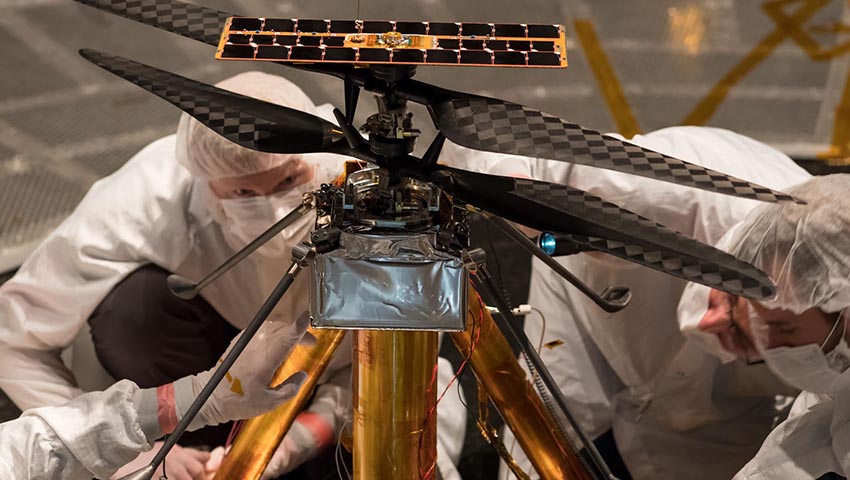In late January 2019, all the pieces making up the flight model (actual vehicle going to the Red Planet) of NASA's Mars Helicopter were put to the test. Weighing in at no more than 1.8 kilograms, the helicopter is a technology demonstration project currently going through the rigorous verification process certifying it for Mars.
The majority of the testing the flight model is going through had to do with demonstrating how it can operate on Mars, including how it performs at Mars-like temperatures. Can the helicopter survive – and function – in cold temperatures, including nights with temperatures as low as minus 90 degrees?
All this testing is geared towards February 2021, when the helicopter will reach the surface of the Red Planet, firmly nestled under the belly of the Mars 2020 rover. A few months later, it will be deployed and test flights (up to 90 seconds long) will begin – the first from the surface of another world.
MiMi Aung, project manager for the Mars Helicopter at NASA's Jet Propulsion Laboratory in Pasadena, California, said, "Gearing up for that first flight on Mars, we have logged over 75 minutes of flying time with an engineering model, which was a close approximation of our helicopter."
While flying helicopters is commonplace here on Earth, flying hundreds of millions of kilometres away in the thin Martian atmosphere is something else entirely. And creating the right conditions for testing here on Earth presents its own set of challenges.
"The Martian atmosphere is only about 1 per cent the density of Earth's. Our test flights could have similar atmospheric density here on Earth – if you put your airfield 100,000 feet (30,480 metres) up. So you can't go somewhere and find that. You have to make it," Aung explained.
Aung and her Mars Helicopter team did just that in JPL's Space Simulator, a 25-foot-wide (7.62-metre-wide) vacuum chamber. First, the team created a vacuum that sucks out all the nitrogen, oxygen and other gases from the air inside the mammoth cylinder. In their place, the team injected carbon dioxide, the chief ingredient of Mars' atmosphere.
The Mars Helicopter's first flight was followed up by a second in the vacuum chamber the following day. Logging a grand total of one minute of flight time at an altitude of five centimetres, more than 1,500 individual pieces of carbon fibre, flight-grade aluminum, silicon, copper, foil and foam have proven that they can work together as a cohesive unit.
The Mars Helicopter project at JPL manages the helicopter development for the Science Mission Directorate at NASA Headquarters in Washington. NASA's Launch Services Program, based at the agency's Kennedy Space Centre in Florida, is responsible for launch management.
The Mars Helicopter will launch as a technology demonstrator with the Mars 2020 rover on a United Launch Alliance Atlas V rocket in July 2020 from Space Launch Complex 41 at Cape Canaveral Air Force Station, Florida. It is expected to reach Mars in February 2021.
The 2020 rover will conduct geological assessments of its landing site on Mars, determine the habitability of the environment, search for signs of ancient Martian life, and assess natural resources and hazards for future human explorers. Scientists will use the instruments aboard the rover to identify and collect samples of rock and soil, encase them in sealed tubes, and leave them on the planet's surface for potential return to Earth on a future Mars mission.

